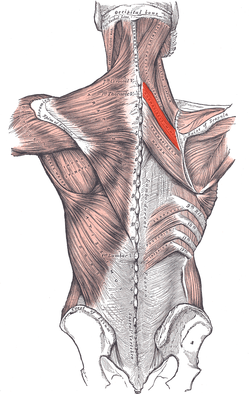|
Rhomboid minor muscle
In human anatomy, the rhomboid minor is a small skeletal muscle of the back that connects the scapula to the vertebrae of the spinal column.[1] It arises from the nuchal ligament, and the 7th cervical and 1st thoracic vertebrae and intervening supraspinous ligaments; it inserts onto the medial border of the scapula. It is innervated by the dorsal scapular nerve. It acts together with the rhomboid major to keep the scapula pressed against the thoracic wall.[2] AnatomyOriginThe rhomboid minor arises from the inferior border of the nuchal ligament, from the spinous processes of the vertebrae C7–T1, and from the intervening supraspinous ligaments.[3] InsertionIt inserts onto a small area of the medial border of the scapula at the level of the scapular spine.[4] InnervationIt is innervated by the dorsal scapular nerve (a branch of the brachial plexus), with most of its fibers derived from the C5 nerve root and only minor contribution from C4 or C6.[5] Blood supplyThe rhomboid minor receives arterial blood supply from the dorsal scapular artery.[6] RelationsIt is located inferior to levator scapulae, and superior to rhomboid major.[citation needed] It lies deep to trapezius, and superficial to the long spinal muscles.[3] VariationIt is usually separated from the rhomboid major by a slight interval, but the adjacent margins of the two muscles are occasionally united.[7] Actions/movementsTogether with the rhomboid major, the rhomboid minor retracts the scapula when trapezius is contracted. Acting as a synergist to the trapezius, the rhomboid major and minor elevate the medial border of the scapula medially and upward, working in tandem with the levator scapulae muscle to rotate the scapulae downward. While other shoulder muscles are active, the rhomboid major and minor stabilize the scapula.[8] Additional imagesReferences
External linksWikimedia Commons has media related to Rhomboid minor muscles.
|
||||||||||||||||||||||||||||||




